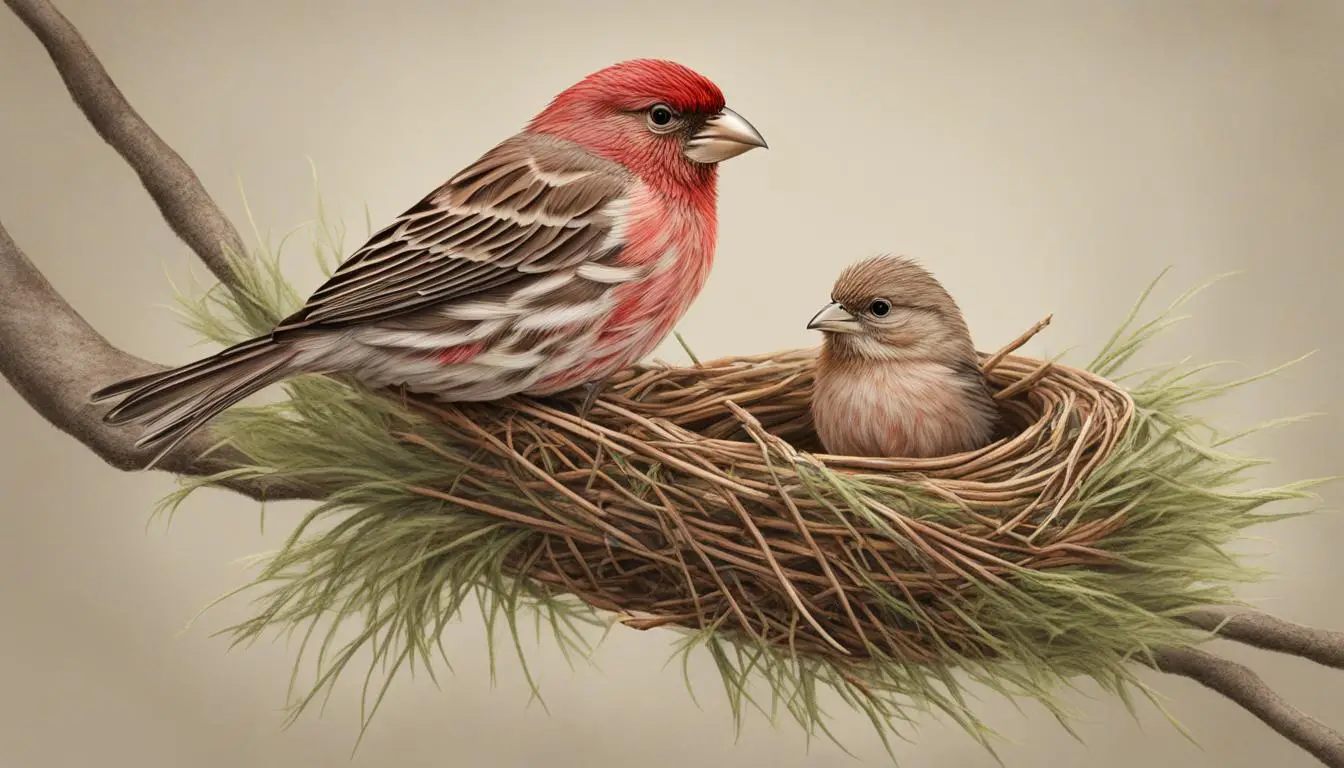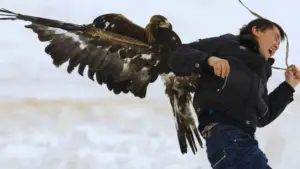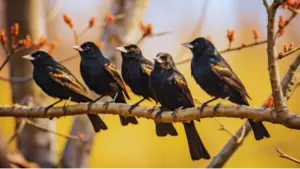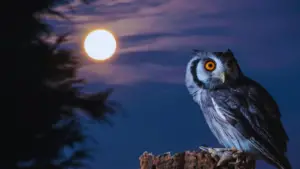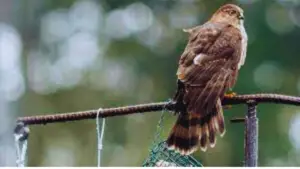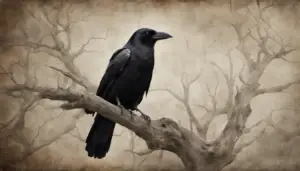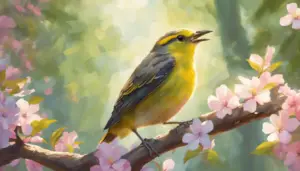Imagine yourself strolling through a stunning garden filled with colorful flowers and the tranquil sound of birds. As you admire the natural beauty around you, your eyes are drawn to a small, intricately constructed nest nestled among the branches of a tree. This is no ordinary nest – it is the handiwork of a house finch, a master architect of the avian world.
In this article, we will explore the fascinating world of house finch nests and the remarkable creatures that create them. We will delve into their nesting habits, the intricate design of their nests, and the crucial role these nests play in the ecosystem.
Additionally, we will discuss conservation efforts aimed at protecting these remarkable birds and their precious homes.
So, join us on this journey as we uncover the heartwarming sight of avian architecture that is the house finch nest. Prepare to be amazed by the beauty and importance of these incredible structures, and discover a new appreciation for the wonders of the natural world.
Key Takeaways
- House finches are small birds native to North America with vibrant red plumage on males and gentle chirping melodies.
- Nest construction is a cooperative effort between male and female finches, with females playing a significant role in weaving the nests using twigs, grass, and other plant materials.
- The nest structure of house finches consists of cup-shaped nests built in trees, shrubs, or buildings, with a sturdy foundation of twigs and small branches, lined with grass and feathers, and camouflaged with moss or lichen on the outer layer.
- House finch nests are strategically placed in hidden and protected locations, with high walls for security, and play a vital role in sustaining ecosystems by providing shelter for young finches and other birds, as well as supporting insect life.
Introduction to House Finches
Get ready to learn all about the charming House Finches and their incredible nest-building skills! These small birds are known for their vibrant red plumage on the males and their gentle chirping melodies. House Finches are native to North America and can be found in a variety of habitats, from urban areas to rural landscapes.
When it comes to building their nests, House Finches are true architects. They use a combination of twigs, grass, and other plant materials to create a sturdy and cozy home for their offspring. The female House Finch plays a significant role in nest construction, while the male helps by gathering materials and providing support.
House Finch nests are typically cup-shaped and are often built in trees, shrubs, or even in the nooks and crannies of buildings. These nests are carefully woven together, creating a snug and secure space for the eggs and hatchlings. It’s truly remarkable to witness the dedication and craftsmanship that goes into each nest.
The nests of House Finches are not only functional but also reflect the unique personalities of the birds that build them. Some nests are elaborate, while others are more simplistic. Regardless of their design, each nest is a testament to the resourcefulness and adaptability of these incredible creatures.
So next time you spot a House Finch nest, take a moment to appreciate the remarkable avian architecture on display.
The Nesting Habits of House Finches
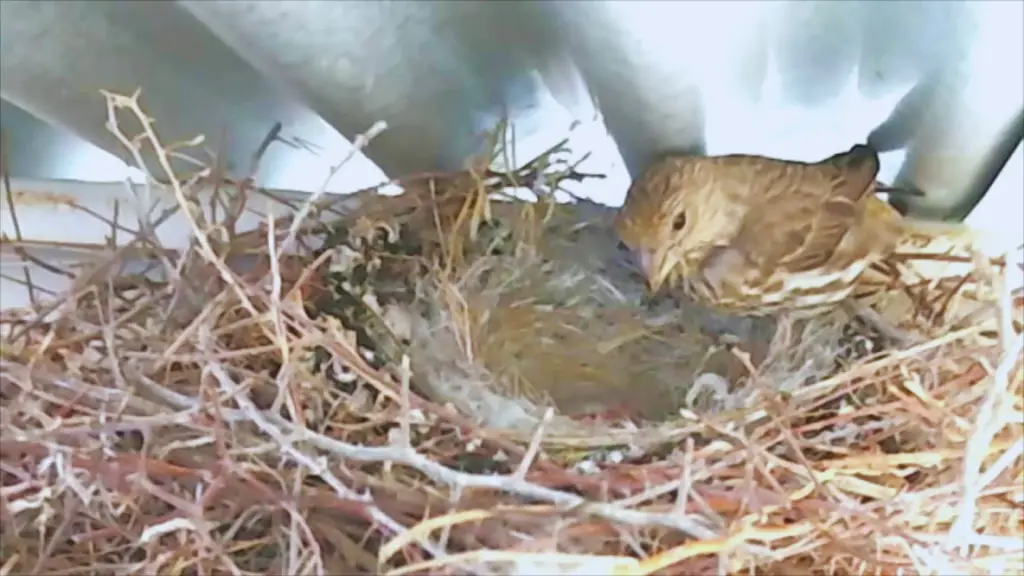
Starting with the word ‘Witnessing,’ the nesting habits of these small birds create a mesmerizing dance of construction and care. House finches are meticulous in selecting a suitable nesting site, often choosing shrubs, trees, or even man-made structures. Once a location is chosen, the female house finch takes charge of building the nest. She skillfully weaves materials such as twigs, grass, and feathers together, creating a sturdy and comfortable structure. As she works, the male house finch diligently gathers food to provide for his mate. This cooperative effort showcases their strong bond and commitment to each other and their future offspring.
To truly appreciate the dedication and beauty of house finch nests, take a look at the table below:
| Nesting Material | Symbolism |
|---|---|
| Twigs | Strength |
| Grass | Comfort |
| Feathers | Warmth |
| Meticulous Construction | Care |
Each item in the table represents a deeper meaning behind the construction process. The twigs symbolize the strength of the bond between the house finch pair, while the grass represents the comfort they provide to their young. The feathers bring warmth, ensuring the nest is a safe and cozy home. Lastly, the meticulous construction reflects their care and attention to detail, ensuring the nest is perfect for their little ones.
In conclusion, observing the nesting habits of house finches is a truly heartwarming experience. Their dedication and teamwork create a beautiful display of avian architecture that evokes a sense of awe and admiration.
Nest Architecture and Design
Witness the intricate design and thoughtful construction of these cozy homes, where every element is carefully chosen to ensure the utmost comfort and safety for their precious occupants. House finches are true architects, creating nests that are both functional and aesthetically pleasing.
These avian artisans use a variety of materials to build their nests, including twigs, grass, and leaves.
The nest architecture of house finches is truly remarkable. They start by weaving a sturdy foundation of twigs and small branches. Then, they line the interior with soft materials like grass and feathers, creating a cozy and warm space for their eggs and chicks. The outer layer of the nest is often camouflaged with moss or lichen, blending seamlessly with the surrounding environment.
But it’s not just about the materials. House finches pay careful attention to the design and placement of their nests. They choose locations that are well-hidden and protected from predators, such as tree branches or building ledges. The nests are built in a cup shape, with high walls to provide security and prevent chicks from falling out.
Every aspect of the nest construction is purposeful and strategic. House finches take pride in their architectural prowess, creating a safe and comfortable haven for their young.
Witnessing the intricate and thoughtful design of these nests is truly a heartwarming sight.
Egg-laying and Incubation

Imagine the excitement you feel as you carefully watch a mother bird delicately lay her eggs in a hidden spot, anticipating the miraculous process of incubation and the hatching of new life.
The house finch, with its remarkable nest architecture, creates a cozy and secure environment for its eggs. After the female house finch lays each egg, she carefully settles into her nest, using her body warmth to provide the necessary heat for incubation.
Incubation is a critical stage in the development of the eggs. The mother bird diligently maintains a constant temperature, ensuring the embryos receive the optimal conditions for growth. This process typically takes around 12 to 14 days, during which the mother bird rarely leaves the nest. She instinctively knows that the eggs need her constant presence to thrive.
As the days pass, you can’t help but marvel at the dedication and resilience of the mother bird. She endures varying weather conditions, protecting her eggs from the elements and predators. She takes short breaks to stretch her wings and find food, but quickly returns to resume her incubation duties.
Finally, the long-awaited moment arrives. You witness the tiny cracks appearing on the eggs, signaling the imminent arrival of new life. The mother bird becomes more restless, sensing the nearing hatching process. And then, one by one, the baby house finches emerge, filling the nest with their presence and the promise of a new generation.
Watching the egg-laying and incubation process of a house finch nest is truly a heartwarming experience. It reminds us of the beauty and resilience of nature, and the incredible journey of life that begins with something as delicate as an egg.
Parental Care and Feeding
During the incubation period, the mother bird’s unwavering dedication ensures the optimal conditions for her eggs to grow and thrive. She diligently sits on her nest, keeping her eggs warm with the heat of her body. The mother bird knows that maintaining a consistent temperature is crucial for the development of her eggs. She turns them regularly to ensure that each side is evenly warmed and receives the necessary oxygen. Her instincts guide her, and she rarely leaves the nest, only to quickly grab a bite to eat or take a short break.
The father bird also plays a role in the parental care and feeding of the house finch nest. He takes on the responsibility of bringing food to the mother while she is incubating the eggs. He tirelessly searches for insects, seeds, and berries to bring back to the nest. The mother eagerly awaits his return, chirping with anticipation. When he arrives, she gratefully accepts the food and quickly consumes it to replenish her energy.
As the days pass, the mother’s dedication remains steadfast. She continues to care for her eggs, ensuring they are safe and protected. She patiently waits for the day when her chicks will hatch, knowing that her hard work and sacrifice will be rewarded with the sight of her precious babies.
Nestling Development
As a nestling, your growth and feather development will be rapid and fascinating to watch. You will quickly develop from a helpless hatchling to a fully feathered bird ready to leave the nest.
Fledging and leaving the nest is an important milestone in your life, marking the beginning of your independent journey in the world.
Growth and Feather Development
Witness the awe-inspiring transformation as the house finch chicks sprout delicate feathers, evolving into graceful creatures fit for the skies.
At around ten days old, the nestlings start developing their first set of contour feathers, which are essential for flight. These feathers grow rapidly, covering their bodies in a soft, downy coat.
As the days pass, the feathers become more defined and stiff, aiding the chicks in maintaining their body temperature and providing protection from the elements. Their once bald appearance is replaced by a sleek and beautiful plumage, with distinct markings and colors that vary among individuals.
With each passing week, the chicks’ feathers continue to grow, becoming stronger and more vibrant. Witnessing this remarkable growth and feather development is a true testament to the incredible resilience and beauty of nature.
Fledging and Leaving the Nest
Prepare yourself for an exhilarating moment as you watch these fearless creatures take their first leap into the unknown. They spread their wings and soar into the vast open sky, leaving the safety of their cozy home behind. This stage is known as fledging, and it is a crucial step in their journey towards independence and adulthood.
There are four key aspects of the fledging process. First, the nestlings must be physically ready. They develop strong flight muscles, and their feathers are fully grown, allowing them to navigate the air effortlessly.
Next, the young finches engage in practice flights. Before fully fledging, they take short flights within the vicinity of the nest. This helps them hone their flying skills and build confidence.
During this stage, the adult finches provide parental guidance. They closely monitor their offspring, offering guidance, protection, and food as needed. The adult finches play a crucial role in ensuring the fledglings’ successful transition into the world.
Finally, the fledglings gradually spend more time away from the nest. They explore their surroundings and discover their own sources of food. This gradual departure marks their transition into independence.
Witnessing these tiny creatures take flight is a remarkable sight. It showcases the beauty and resilience of nature, as these young finches embark on their own unique journeys.
Nest Predators and Threats
Beware, for lurking in the shadows are cunning predators that threaten the safety of the house finch nest. These tiny avian architects put their heart and soul into building a safe haven for their precious eggs and nestlings. However, despite their best efforts, numerous threats loom over their delicate creation.
One of the biggest threats to the house finch nest is the domestic cat. With their stealthy paws and sharp claws, they can easily climb trees and snatch the defenseless chicks. Additionally, squirrels are notorious nest invaders. Their nimble acrobatics allow them to access the nest, stealing eggs or even claiming the nest as their own.
To further illustrate the dangers these nests face, let’s take a look at the table below:
| Predators | Threat Level |
|---|---|
| Domestic Cats | High |
| Squirrels | Medium |
| Snakes | Low |
| Hawks | High |
| Raccoons | Medium |
As you can see, some predators pose a high threat, while others pose a medium or low threat. It’s crucial for the house finch parents to remain vigilant and protect their nest from these predators. They must constantly be on guard, ensuring the safety of their precious brood.
The Role of House Finch Nests in the Ecosystem
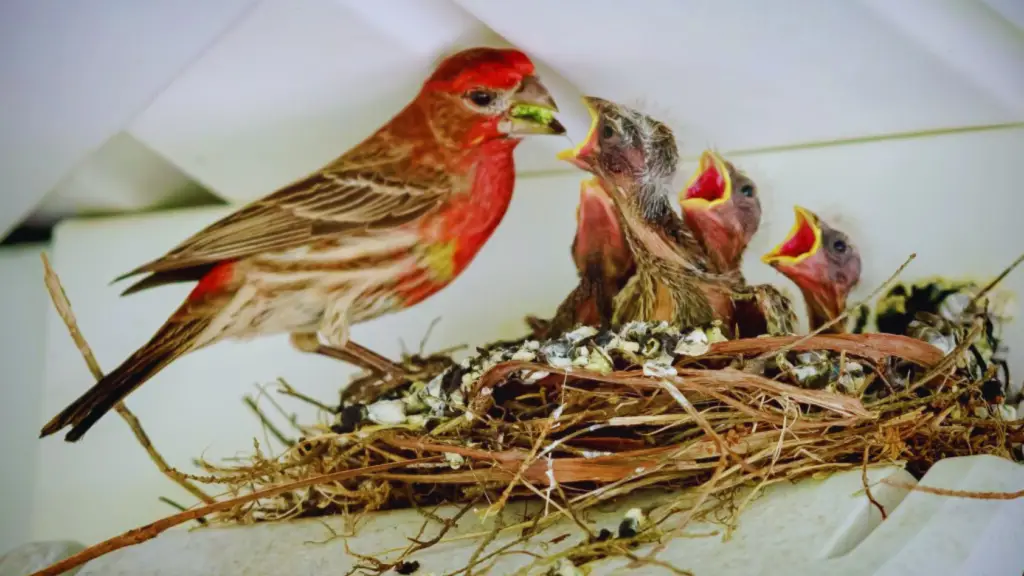
Imagine yourself standing in the midst of a vibrant ecosystem, where tiny havens of new life offer hope and sustenance to a variety of creatures. In this miraculous web of life, the house finch nest plays a crucial role.
These nests, meticulously crafted by the finches, provide shelter and protection not only for the young finches but also for other small birds seeking a safe haven.
The house finch nest is a masterpiece of avian architecture. Built with twigs, grass, and other natural materials, it provides a sturdy and cozy home for the finch chicks. But its importance extends beyond the finch family. Other birds, such as sparrows and warblers, often seek out these nests for their own use. They find refuge from predators and inclement weather, as well as a safe place to lay their own eggs.
Additionally, the house finch nest plays a vital role in the ecosystem by supporting a diverse range of insect life. Insects, such as beetles and spiders, often inhabit the nooks and crannies of the nest, providing a source of food for the finches and other birds. This intricate interplay between nest, birds, and insects creates a delicate balance that sustains the ecosystem.
So next time you come across a house finch nest, take a moment to appreciate the intricate web of life it represents. From the tiny finch chicks to the visiting sparrows and the buzzing insects, this humble nest serves as a symbol of hope and resilience in the natural world.
Encountering a House Finch Nest: What to Do
When encountering a house finch nest, it’s important to remember to observe from a distance. Getting too close can cause stress to the birds and may even lead to abandonment of the nest.
If you do come across a nest, consider reporting the sighting to citizen science projects, such as NestWatch, to contribute valuable data to the study of bird populations and nesting behaviors.
Observing from a Distance
From your vantage point, you can witness the house finch nest construction without disturbing the birds, which is important because female house finches have been found to abandon nests if they detect human interference. It’s fascinating to see the meticulous work of these tiny architects.
The male house finch brings twigs, grasses, and other materials to the female, who skillfully weaves them together to create a cozy nest. They carefully select a sturdy branch or ledge to build upon, ensuring the safety of their future chicks.
As you observe from a distance, you can see the female shaping the nest with her body, pressing the materials together to form a secure structure. It’s a heartwarming sight to witness the dedication and care these birds put into creating a safe home for their offspring.
Reporting Nest Sightings to Citizen Science Projects
You can actively contribute to scientific research by reporting your observations of nest sightings to citizen science projects. This fosters a sense of connection and empowerment as you become an integral part of the collective effort to understand and protect these delicate ecosystems.
By sharing your findings with these projects, you provide valuable data that helps scientists track the population trends, nesting behaviors, and distribution patterns of house finches. This information is crucial for conservation efforts and can guide future research and management strategies.
Participating in citizen science projects also allows you to join a community of like-minded individuals who share a passion for birds and nature. You can learn from others, exchange knowledge, and contribute to the overall understanding of avian architecture.
Your reports truly make a difference and contribute to the conservation of house finch nests and the preservation of their habitats.
Conservation Efforts for House Finches
Conservationists have made significant strides in protecting house finches and their habitats. By implementing various conservation efforts, these beautiful birds are now thriving in many areas.
One of the key initiatives is the creation of protected areas specifically designed for their nesting and breeding. These areas provide safe and suitable habitats for house finches to build their nests and raise their young.
In addition to protected areas, conservationists have also focused on educating the public about the importance of preserving house finch habitats. By raising awareness about the threats these birds face, such as habitat loss and the spread of diseases, people are encouraged to take action and support conservation efforts.
Another crucial aspect of conservation is the monitoring of house finch populations. By regularly monitoring these birds, conservationists can gather valuable data on their population trends, behavior, and overall health. This information helps in identifying potential threats and developing targeted conservation strategies.
Furthermore, conservationists work closely with local communities to promote responsible practices that benefit both house finches and humans. This includes planting native plants that provide food and shelter for the birds, as well as implementing measures to reduce the use of pesticides that can harm their populations.
Thanks to the dedicated efforts of conservationists, house finches now have a brighter future. With continued conservation initiatives and public support, these charming birds will continue to grace our gardens and bring joy to our lives.
Conclusion: Appreciating the Beauty and Importance of House Finch Nests
Imagine a world where intricate woven masterpieces hang delicately from trees, showcasing the ingenuity of nature’s architects. This is the world of house finch nests. These nests are not just ordinary structures; they are a testament to the beauty and importance of avian architecture.
When you come across a house finch nest, you can’t help but be amazed by the intricate weaving of twigs, grass, and other materials. It’s a true work of art, showcasing the finch’s ability to create a safe and cozy home for their young. The attention to detail is astounding, with every piece carefully chosen and placed.
But these nests are not just beautiful to look at; they serve a vital purpose in the finch’s life. They provide a safe haven for their eggs and young, protecting them from predators and the elements. The carefully woven structure also helps to regulate temperature, keeping the nest warm in winter and cool in summer.
As you observe a house finch nest, take a moment to appreciate the dedication and hard work that went into its construction. These nests are a reminder of the incredible resilience and adaptability of nature. So next time you come across a house finch nest, take a moment to marvel at its beauty and importance. It’s a sight that truly warms the heart.
House Finch Nests: FAQs
Can house finches reuse their nests from previous breeding seasons?
Yes, house finches can reuse their nests from previous breeding seasons. They often make repairs and additions to the nest before reusing it, ensuring a safe and familiar home for their new brood.
How long does it take for a house finch nest to be built?
It takes house finches about 4-6 days to build their nests. They gather materials like twigs, grass, and feathers, weaving them together to create a cozy home for their eggs.
Do house finches defend their nests against other bird species?
Yes, house finches are known to fiercely defend their nests against other bird species. They will aggressively chase away intruders, ensuring the safety of their precious nest and young.
Are there any specific materials that house finches prefer to use in their nests?
House finches prefer to use specific materials in their nests, such as twigs, grass, and feathers. These materials help provide structure and insulation for the nest, ensuring a safe and comfortable environment for their offspring.
Do house finches build their nests in the same location every year?
House finches do not build their nests in the same location every year. In fact, studies show that they tend to choose new spots, with only 10% of nests being built in the same location.
Conclusion
In conclusion, you should take a moment to appreciate the beauty and importance of House Finch nests. These tiny avian architects create intricate structures that provide a safe haven for their eggs and chicks.
The care and dedication these birds show in building and maintaining their nests is truly remarkable. As the saying goes, ‘A bird’s nest is a masterpiece of structural engineering,’ and House Finch nests are no exception.
So next time you come across one, take a moment to marvel at the incredible work of these feathered builders.

